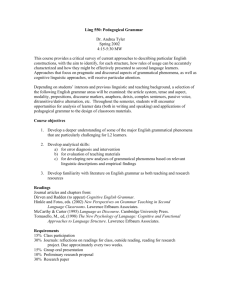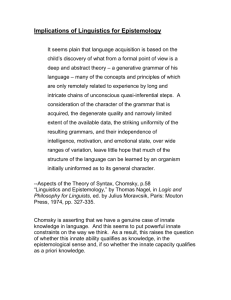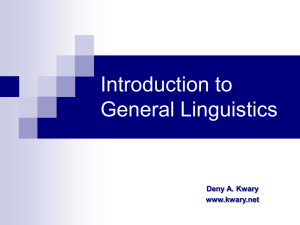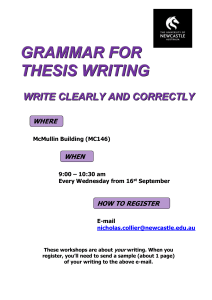7 Universal Grammar - Carleton University
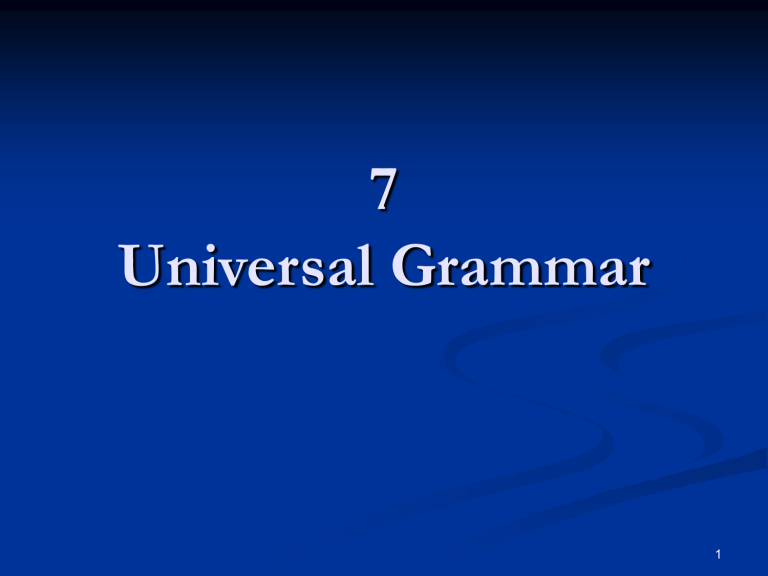
7
Universal Grammar
1
Slides on the net at:
http://http-server.carleton.ca/~ecorazza/
http://httpserver.carleton.ca/~ecorazza/online_courses/Mind_World_and
_knowledge/
2
Chomsky’s Epiphenomenalism about Language
Language
vs.
Grammar
“Grammar” is a precise definite term while “language” is a vague and derivative term which we could well dispense of, without much loss.
The grammar in someone mind/brain is real while language is not.
3
The aim of linguistics can be summarized by four questions.
1. What constitutes knowledge of language?
2. How is such knowledge acquired?
3. How is such knowledge put to use?
4. What are the physical mechanisms that serve as the material basis?
4
Deep
vs.
Surface Structure
Port Royal Grammar (1660)
It is heavily influenced by Descartes.
It aims to propose the general form of any possible grammar.
In so doing it elaborates the universal structure underlying the “natural manner in which we express our thoughts”.
5
The inner/outer aspect of language
According to Port Royal grammarians we must distinguish between language having an inner and an outer aspect.
Hence we distinguish between a sentence qua expression of a thought and the physical shape of a sentence (i.e. an utterance).
To show the structure of the mind the grammar should reflect properties of all minds , it should be universal .
6
Mental Grammar
The deep structure is often only implicit and does not get expressed. It is only represented in the mind.
The same deep structure can be realized differently in different languages (e.g.: “Video canem currentum” and
“Je vois un chien qui court”).
The rules of this grammar are not represented in the language user: they are simply there. Yet they must be
“learned”. But see poverty of the stimulus argument.
7
Transformation Rules
There are transformation rules operating from deep to surface structure. It is the linguist’s job to figure out these rules.
The grammarians of Port Royal are the first to recognize the two systems of rules:
1. A base system generating deep structure.
2. A transformational system mapping these deep structures into surface structure.
8
UG
UG corresponds to the deep structure. Since it is the expression of though, it is common to all languages.
It is thus universal. Hence Universal Grammar, UG.
The transformation rules converting the deep structure into surface structure may differ from language to language.
Different outputs can correspond to the same inner structure.
9
Port Royal
Within the Cartesian tradition exemplified by the grammarians of Port Royal, the deep structure is what constitutes the meaning (sense) in the mind.
It can be transmitted in different way (e.g.: active/passive).
E.g.: different languages or different surface structures transmit the same meaning/sense which is a mental entity.
10
Nowadays UG means the learner.
initial state
of a language
It is the “innate” (genetically transmitted) aspect of grammatical rules; the
language instinct
(Pinker).
It is that aspect of the human mind that causes one to learn the language.
UG qua initial state is
biologically determined
.
As such, it does not belong to a specific language.
11
UG need not be supposed to be what is universal
among languages (see Jackendoff 2002: 72ff.).
It is merely the human allowing one to learn
capacity
, i.e., the
initial state
,
a
language.
The aspects of the initial sate one ends up using in one’s learning periods depends on the stimuli/input.
Languages (inputs) affect the development of the initial state and thus the outputs one ends up producing (cf. switches metaphor explaining the learning of phonetics).
12
Innate
We do not necessarily mean that it is present at birth or in an embryo.
It rather means that it automatically appears during the development, regardless on whether it is present at birth or not.
It does not mean that it is free from the input of the environment. E.g. vision capacity.
13
Deep
vs
. Surface Structure, and Creativity
The deep/surface structure distinction is what helps explaining linguistic creativity.
The Port Royal’s distinction between deep and surface structure implicitly contains recursive devices allowing for infinite uses of the finite means that it disposes.
The deep structure is what gets represented in the mind when a sentence is produced/heard (see LF).
14
Linguistic creativity and the argument for mental grammar
The expressive variety of language use implies that the brain of a linguistically competent user contains a set of unconscious grammatical principles.
(cf. Jackendoff R. 1994. Patterns in the Mind. Basic Books
Harper Collins, New York: 6).
15
LOT
In adopting the language of thought hypothesis, LOT
(or Mentalese) the argument for mental grammar can be stated along the compositional principle for thoughts, or what Fodor characterizes as the productivity of thought.
The classical argument that mental states are complex adverts to the productivity of the attitudes … The LOT story is, of course, a paradigm of this sort of explanation, since it takes believing to involve a relation to a syntactically structured object for which a compositional semantics is assumed. (Fodor J. 1987.
Psychosemantics. MIT: 147-8)
16
Logical
vs
. Grammatical Form
Arnauld & Nicole (in Port Royal Logic 1662: 160) highlight the difference between deep (logical) structure and surface (grammatical) structure.
In:
(1) Now few pastors at the present time are ready to give their life for their flocks the grammatical (surface) structure is affirmative, while its underlying structure (LF) is negative.
17
(1) contains the implicit negative sentence (“it contains this negation in its meaning”):
(1a) Several pastors at the present time are not ready to give their lives for their flocks
The same with:
(2) Come see me whose deep structure is:
(2a) I order/beg you to come see me
18
According to the Port Royal grammarians there is a transformation enabling to go from (1a/2a) (deep structure) to (1/2) (surface structure).
We have hidden underlying structure and a grammatical transformations operating between the deep structure
(LF) and the surface (or grammatical) structure.
E.g.: the surface structure “Only the friends of God are happy” is a transformation of the deep structure “The friends of God are happy” and “all other who are not friend of God are not happy”.
19
Understanding
To understand a sentence one must grasp the sense, i.e. the meaning (“natural order”) the speaker has in mind.
One grasps it in reconstructing its meaning, i.e. in coming to entertain its underlying structure (LF) and the meanings of the single words.
The fundamental principles at work are
reordering
and
ellipsis
which enable the hearer to recover in her mind the meaning the speaker has in her.
20
Linguistic explanation and description
Grammaire Générale
(Port Royal)
Cartesian linguistics did not confine to a mere description of a language and its grammar.
It aimed to capture the universal (mental) structure underlying languages.
21
Port Royal grammar, like modern (Chomsky’s inspired) linguistics can be viewed as a branch of psychology or cognitive sciences.
The general grammar is a kind of universal grammar.
As such, it differs from the special grammar which is language specific. It differs from the grammar of
English, Chinese, etc.
22
Linguistics/General Grammar as a Science
General Grammar is … the rational science of the immutable and general principle of spoken and written language, whatever language this may be … General Grammar is a science, because its object is rational speculation on the immutable and general principle of language … The science of grammar is anterior to all languages in so far as its objects presuppose only the possibility of languages and are the same as those which guide human reason in its intellectual operations … because they are eternally true (Bauzé 1767).
23
Shortcomings of Cartesian
Linguistics (1600-1700)
The underlying assumption
UG (the abstract structure underlying a natural language sentence) is a kind of sentence itself.
It is generally assumed that deep structure consists of actual sentences in a simpler or more natural organization.
24
The underlying assumption is gratuitous and can be
dismissed.
It rests on the Cartesian idea that the general principles underlying and determining our thoughts and perceptions must be can be brought to consciousness with care and attention.
accessible to introspection
and
If we assume that UG is entities.
unconscious
we don’t have to assume that the general principle are sentence-like
25
Language acquisition
Universal Conditions
They are not learned and must exist for language knowledge to be explained.
They are the pre-requisite leading to knowledge: principles or notions implanted in the mind … a direct gift of
Nature, a percept of natural instinct … [they] remain latent when their corresponding objects are not present, and even disappear and give no sign of their existence (Herder 1624).
26
This contrasts with the empiricist view that our mind is a clean sheet, as though we obtained our capacity for dealing with objects from objects themselves (Herder 1624).
The mind is not a tabula rasa.
27
Nativism/Innatism
The universal principles are innate and implicit.
Yet, we may require external stimulus to activate them and make them available to introspection.
This is one of the main principles underlying the psychology of Cartesian linguistics and rationalism in general (see e.g. Leibniz).
[I]t is true that it is purely arbitrary to connect a certain idea to one particular sound rather than another. But ideas—at least those that are clear and distinct—are not at all arbitrary things depending on our fancy. (Arnauld & Nicole 1662: 28)
28
Plato’s Problem
Nativism provides a solution to Plato’s problem (cf.
Plato’s Meno and Theaetetus).
For it provides a science of language that shows how an internal biological mechanism can, with little input from the external environment (poverty of the stimuli argument) develop (almost automatically) in each individual the rich competence known as “knowing a language”.
29
Solving Plato’s problem for language acquisition
It involves saying both what is known when one knows a language and how one comes to know it.
We should do this with a science of the mind, not philosophical speculations.
30
Chomsky
vs
. Plato
Plato appeals to myth, invoking the pre-existence of the boy’s soul with other souls in the world of Forms
(ideas) and in going trough a process of reminiscence.
Chomsky solves it in proposing a naturalistic theory of a biological system that makes language acquisition virtually automatic.
31
General Presuppositions of Cartesian
Linguistics
The principle of language and natural logic are known unconsciously and they are in large part a precondition for language acquisition rather than a matter of institution or training.
Linguistics as a science trying to bring to light these underlying principles becomes a branch of psychology.
Thus this art [logic or art of thinking] does not consist in finding the mean to perform these operations, since nature alone furnished them in giving us reason, but in reflecting on what nature makes us do. (Arnauld & Nicole 1662: 23)
32
The Poverty of the Stimulus
Argument
General language-acquisition schema
Input
LAD
Output
(primary (Grammar consisting of linguistic data) principles, parameters and lexicon)
33
Language acquisition is a matter of growth and maturation of relatively fixed principles under appropriate external conditions and training.
Cf. growth and maturation of bones: the structure of the bones is genetically programmed, yet it needs exercise to develop.
34
Creolization
One learns a language because one is programmed to learn a language, i.e. because of one’s initial state, UG.
The process of creolization underlies what happens when a child learns her mother tongue in normal situations.
The same kind of linguistic genius is involved every time a child learns his or her mother tongue. ... let us do away with the folklore that parents teach their children language. (S. Pinker.
1994. The Language Instinct: 39)
35
The crux of the argument is that complex language is universal because children actually reinvent it , generation after generation — not because they are taught, not because they are generally smart, not because it is useful to them, but because they just can’t help it. (Pinker 1994: 32)
The argument of innate knowledge
It rests on the actual way children acquire their mother tongue.
It is an empirical hypothesis which posits that our brain is genetically programmed to invent a language.
36
Chomsky
Large-scale sensory deficit seems to have limited effect on language acquisition. Blind children acquire language as the sighted do, even color terms and words for visual experience like
“see” and “look.” There are people who have achieved close to normal linguistic competence with no sensory input beyond that can be gained by placing one’s hand on another person’s face and throat. The analytic mechanism of the language faculty seem to be triggered in much the same way whether the input is auditory, visual, even tactual, and seem to be localized in the same brain areas , somewhat surprisingly.
37
These examples of impoverished input indicate the richness of innate endowment — though normal language acquisition is remarkable enough, as even lexical access shows, not only because of its rapidity and the intricacy of result. Thus very young children can determine the meaning of a nonsense word from syntactic information in a sentence far more complex that they can produce.
A plausible assumption today is that the principles of language are fixed and innate , and that variations is restricted in the manner indicated. Each language, then, is (virtually) determined by a choice of values for lexical parameters: with the array of choices, we should be able to deduce Hungarian; with another, Yoruba. … The conditions of language acquisition make it plain that the process must be largely inner-directed, as in other aspects of growth, which means that all languages must be close to identical, largely fixed by initial state . (Chomsky 2000. New Horizons … : 121-2)
38
The paradox of language acquisition
[A]n entire community of highly trained professionals, bringing to bear years of conscious attention and sharing of information, has been unable to duplicate the feat that every normal child accomplishes by the age of ten or so, unconsciously and unaided . (Jackendoff 1994: 26)
39
Language Perception and Understanding
Perception of speech rests on innate discriminatory capacities.
There is a fundamental difference between the perception of speech and the perception of unarticulated sounds.
Speech perception, unlike visual perception for instance, requires the activation of the generative rules playing the role in the production of speech.
40
Both the perceptual mechanism and the mechanism of speech production make use of the same underlying system of generative rules.
It is because these underlying systems are the same among us that communication can occur.
It is because of this uniformity of human nature that we talk the way we do and succeed in understanding each others (cf. Humboldt 1836).
41
Every young child (raised in an English speaking community) would know that in English ‘blug’ is phonetically possible while ‘bkr’ is not. And they know it without being told.
Science of Intelligent Behaviour
It may be within the boundary of some other cognitive beings (Martians, God) but it transcends human capacities.
42
Reasons
vs
. causes
Wittgenstein (Blue Book) says that in explaining action in terms of their coherence and appropriateness with respect to human aims etc. we “give reasons”, not “give causes”.
When talking about creative linguistic actions Chomsky and Descartes seem to accept Wittgenstein’s view in assuming that we are giving reasons, not causes.
43
Descartes’ dualism
It was a scientific hypothesis dictated by the science of his time (mechanism).
Descartes did not have at his disposal the biological science of our time, he did not know of genetic transmission and could not possibly imagine how human cognition can rest to such an extent on a biological base of concept and structure acquisition.
Descartes could not imagine that these biological mechanisms need only a little input to produce rich conceptual material.
44
At present little is known on how UG is embodied in the brain.
UG is considered as a computational system in the head, but we do not know about the specific operations of the brain itself and what leads to the development of these computational systems.
45
A plausible view is that language is a distinct and specific part of the human mind and not a manifestation of a more general capacity or ability (of general intelligence).
Linguistic capacity rests on a specific module .
It is not the sub-product of a general cognitive capacity.
46
Evidence
People can “lose their intelligence” and yet they do not loose their language: substantial retarded children (e.g.
Williams syndrome) manifest a good grammatical and linguistic competence.
On the other hand, highly intelligent people may lack linguistic capacity (e.g. aphasia).
The fact that two kinds of abilities can dissociate quantitatively and along multiple dimensions shows that they are not manifestations of a single underlying ability. (Pinker 2003: 23)
47
